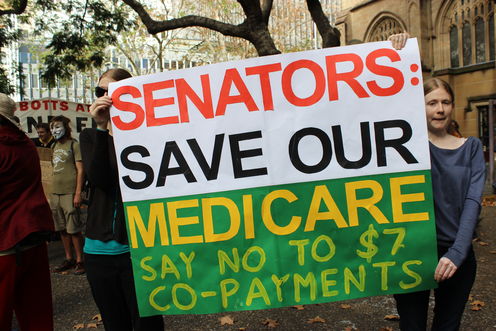
Arguments against health co-payments proposed in May’s federal budget will come to the fore again shortly as the Senate considers whether it will pass the necessary legislation.
The government’s attempt to introduce a $7 compulsory co-payment for visits to doctors and pathology services has attracted strong criticism. The measure is fundamentally flawed because it’s a crude attempt at fitting an economic concept to an industry for which it’s inappropriate.
The health co-payments have been described by the government (and its National Commission of Audit) as a price signal. Both have indicated that they feel it’s needed to reduce “unnecessary” visits to the doctor and use of pathology services.
Price signals work by encouraging consumers to think about whatever it is they are about to buy, and whether it’s worth the cost. They assume some consumer knowledge of the product, and its value. We rely on prices right through the economy to temper consumption.
But this economic common device is inappropriate for primary care because health care is not a commodity or luxury service; it is an essential service that can create much greater downstream costs if not used at the right time.
Excluding from care
The aim of modern health funding is twofold: to ensure people have universal protection against the potentially large financial risk posed by sudden illness and that even people who are poor and sick are not excluded from beneficial health care.
That means co-payments have to have at least some exceptions, otherwise they will do what price signals traditionally do and keep some people out of the market. In other words, without exceptions for people who cannot afford this new cost, they will be excluded from care.
This makes health inequitable; the same co-payment will have a larger deterrent effect on low-income groups than it does for high-income groups.
Evidence from Australia and other countries shows that low-income groups are much more likely to rely on general practitioners than visit more expensive specialists. But it is this less expensive and more accessible (and accessed) service that’s being targeted by the government’s proposal.
Information asymmetry
The chairman of the National Commission of Audit, the treasurer and the health minister have all claimed that Australians go to the doctor too often. They suggest the introduction of a price signal for health in the form of co-payments will only reduce trivial visits.
This leads to the second problem with the measure: relying on patients to judge which doctor visits and treatments are valuable.
Doctors have a lot more training and knowledge than their patients and so patients rely on them for advice. Thus the aphorism, you need to see the doctor to tell you whether you need to see a doctor.
This is particularly the case with primary care, which often acts as the gate keeper to other health-care services. Patients go to their primary-care provider for many and varied reasons, but the value of those visits is only apparent after the fact.
Co-payments cannot operate as an effective price signal if people can’t judge the quality of what they’re buying. They will simply stop going if they cannot afford to pay.
The aim of introducing co-payments is to reduce costs to government but repeated studies have shown that lower overall costs do not necessarily follow.
The combination of being highly price sensitive (or being unable to afford care) and the inability to judge when care is required means people who are less well-off are put off from seeking necessary care. And this just ends up being more expensive in the long run as illness is not prevented from getting worse.
A better way
One alternative is that people who can afford it should make the co-payment, while the needy are protected by safety nets and other special arrangements. But safety nets require various tests for eligibility, which introduce more “red tape” (or administrative) costs.
Maybe instead of creating new charging procedures and administrative costs, payments could be collected through the tax system, via general taxation or the Medicare Levy.
This levy was first introduced in 1984, and most recently increased to cover the National Disability Insurance Scheme. Perhaps now is the time to increase it or make it more strongly progressive than it is now (that is, have people on higher incomes contribute more) so it provides the health-care budget with greater surety.
Health services are not like other services; going to the doctor can’t be compared to a visit to the hairdresser or servicing your car.
What may seem like a simple price signal to some is a financial barrier to effective and timely care for others. The consequences of introducing co-payments are not just a loss of fairness but also a false economy.
Government budgets should be instruments of efficiency and equity. Australia is lauded for exactly these things in its health system, it would be a pity to lose our international reputation because of mistaken understanding of an economic concept.
Jane Hall receives funding from the NHMRC and APHCRI.
Richard De Abreu Lourenco receives funding from the NHMRC.
